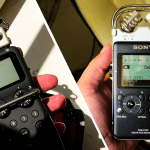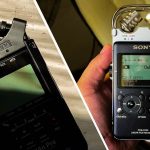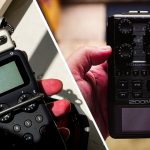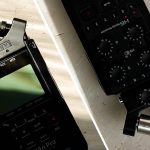I’ve used my Zoom H6 and my Sony PCM-D100 for a while now, and I love them both, but for very different reasons.
I enjoy the simplicity and amazing sound quality of my PCM-D100. When I want to recording something with minimal fuss and bother, then it is my go-to recorder. And if I’m recording outdoor ambiences, the PCM-D100 is what you’ll probably find in my bag.
But, when I need to plug in extra equipment to record a podcast or maybe make a band demo, then hands down it’s the Zoom H6 that I’ll use.
In this article, we will explore the features of these recorders, their similarities and differences and answer your all-important question: “Which one should I choose?”

Versatility
If you want a recorder which can adapt to your needs, then the Zoom H6 is one to consider.
It comes with four XLR inputs which allow you to plug in extra microphones, a boom or even instruments. Now you have many options when recording podcasts, or an all-important demo for your band.
And, the Zoom H6 is also modular. As standard, it now comes with just an X/Y capsules, but you have many more capsule options.
You can clip these to the top as easily as changing the lens on a camera.
If you want a more in-depth dive on what capsules the Zoom H6 can use, and what they’re good for, have a look at my recent Zoom H6 review.
As if the capsules weren’t enough, you can also use the H6 as an audio interface with your computer.
The Sony PCM-D100, on the other hand, concentrates on what it does best; making pristine recordings through its built-in X/Y microphones.
Unfortunately, you can’t use the PCM-D100 as a computer interface, and there are no XLR inputs. While that would be a downside if you were making a podcast, it is a blessing when you want to record without the fuss of cords and extra equipment.
Given the fact that the PCM-D100 has been discontinued, and the fact that it’s hands down the best handheld recorder out there in terms of sound quality, they can be quite pricey on eBay right now. If you want something close to it, look up the PCM-D50, which is the predecessor of the D100. You can find recording samples of it online, and you can decide for yourself whether it’s worth it or not.
I’ve actually just ordered a PCM-D50 for myself, and I’ll review it as soon as it arrives, so if you want to see that, make sure to subscribe to my newsletter.

Build Quality
Both of these portable, digital recorders are designed to take a few knocks.
The sturdy aluminium casing of the D100 helps to keep its weight down. While it’s small enough to hold in your hand, I would always recommend that you secure the recorder to a stand or solid surface because of its sensitivity to movement.
But, the Zoom H6’s rubberised plastic case protects it and helps to diminish noise if you do have to hold the machine while recording.
Realistically, neither of these devices should really be handheld if you’re recording using the on-board mics. The solution to this are these Rycote kits, which I recommend all the time, because they are truly awesome.
You get a quality Rycote windshield, which allows you to record in most windy conditions, a shock mount, which absorbs vibrations, and a grip, which allows you to hold the entire thing.
As a quick side note, each recorder comes with a small carry case. In the case of the Zoom, pun not intended, it’s a straightforward plastic case. It doesn’t look waterproof, but it’ll protect your recorder from anything other than medium to large mammals.
The PCM-D100 case is a bit more posh, and it’ll also carry some of your accessories, like the remote, or some extra batteries.
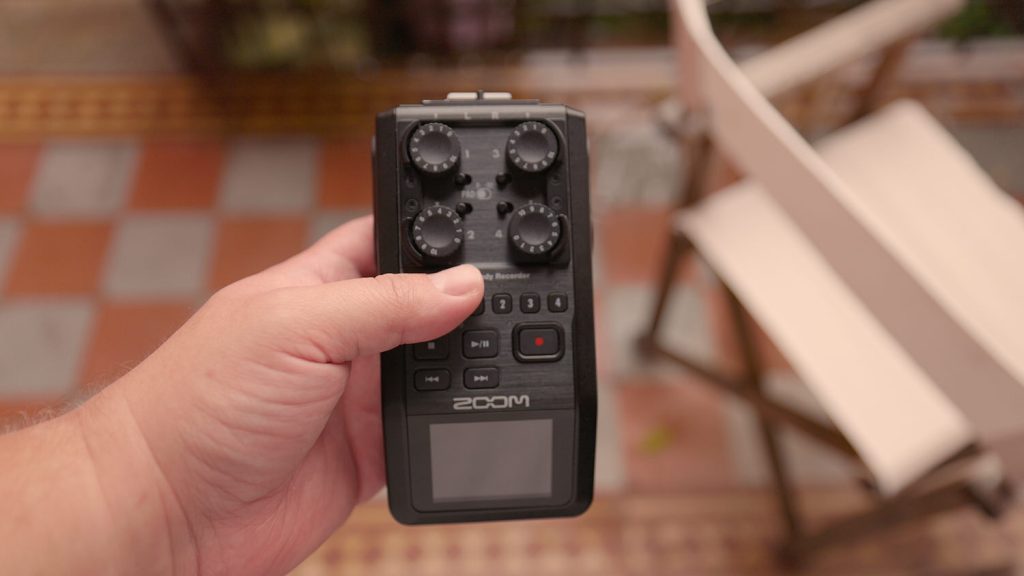
Free Sound Effects
By the way, did you know I have compiled the largest list of free sound effects in the world? Over 500GB of sounds, ready to be downloaded, free of charge. Just figured you’d want to know. And now, back to the review.
Audio Quality
As audio quality is pretty important with recording devices, what can you expect from either? Well, the PCM-D100 wins in most situations.
This is because it has better preamps, and thus produces less hissy recordings, especially when recording super quiet stuff.
The voice overs for my most recent videos were actually recorded on a Zoom H6, with an SGH-6 shotgun mic, so obviously you can get clean recordings with both. But, whilst the H6 wins in terms of versatility, the PCM-D100 does fewer things, but it excels at them.
As a quick side note, I’ve returned back to my Shure SM7B setup, which is what this voice over is recorded with. If you want to see the full setup, I have a link down below.
In short, if you want to plug in loads of mics, the H6 wins by default, as it has multiple inputs, but if you want to record quiet ambiences, quiet instruments, ASMR, etc. the PCM-D100 excels at that.
I also want to briefly talk about sample rate and bit depth. If you’ve read any of my other articles, you’ll know that you should just choose 24 bit, and that sample rate can more or less be likened to frame rate on a camera.
With that in mind, the Zoom H6 can record up to a maximum sample rate of 96kHz, whilst the PCM-D100 can do a staggering 192kHz.
Does this matter for most people? No.
If you’re recording music, you’ll most likely stick to 44.1kHz, or 48kHz. If you’re recording a voice over for video, you’ll still do 48kHz.
The only reason why you’d record at 96Khz is if you’re recording ambiences, or sound effects which will be manipulated later. If you want to really manipulate and stretch your sounds, 192kHz gives you even more flexibility.
Generally, the more kHz, the more you can stretch out and manipulate the sound, kind of like how more frame rates per second means you can slow down the footage more without weird artefacts.
So, if you want to do podcasts, or record normal music, the maximum sample rate on the H6 will suffice. If on the other hand, you like to really play with sound design, you’re probably already gravitating towards the D100 as it is.
Storage & Battery Life
Running out of power, or finding that your storage is full halfway through recording, are things you generally want to avoid.
Fortunately, both these recorders take easy-to-get AA batteries and are economical in their use. Both take four batteries by the way.
Sony reports that you can expect up to 12 hours of battery life, depending on how you’re using the recorder. In the meantime, Zoom claims that its batteries can last up to 20 hours in the right conditions.
I left my H6 to record rain ambiences all night, and it was still going strong the next day. Because of the variable rich nature of audio recording, it’s hard to truly predict battery length.
It’s more or less like asking how long a piece of string is. So bearing that in mind, remember that your milage may vary.
When it comes to storage, I do like the internal/external capacity of the PCM-D100. This device can store 32GB internally, and when that’s full, it can seamlessly swap to an SD card.
There is no internal storage available on the H6; it keeps all data on SD cards. That being said, it can take cards of 32, 64 and even 128Gb, so it still has ample capacity.
Level Controls
When it comes to level controls, in the case of both mics, it’s a breeze. When it comes to the PCM-D100, you have a dial on the side of the recorder, which can be easily adjusted. You even have a safety mechanism that locks the dial in place, so that the levels can’t be accidentally changed.
On the H6, each XLR input is controlled by a separate dial. There are four on the recorder itself, and the clip-on capsules come with dials attached. These aren’t protected, so you do have to be careful not to nudge them by mistake.
Display
When it comes to screens, you can find the Sony’s backlit display on the top front of the recorder. It’s a standard size and shape and can be easily read in most lighting situations.
However, the H6 boasts a tilted 2-inch, full-colour screen at the lower end of the device. It gives the Zoom H6 a distinctly different look compared to the other recorders I’ve reviewed.
The angle makes it easy to see the screen when it’s mounted on a camera or stand. With that in mind, I’ve said it a thousand times, but they really should do a swivel screen system. I don’t understand why they don’t want to add a feature as useful as that.
Who knows.
Size and Build
These recorders are both more substantial in size, preventing that feeling that you’re holding a toy, which can happen with some recorders, but are still small and light enough to carry around easily.
The Sony PCM-D100 is significantly shorter, slimmer and a little lighter than the Zoom H6.
The actual dimensions for the PCM-D100 are 6.1 x 2.8 x 1.2 inches, and it weighs in at just over 390 grams or 13.75 oz. The larger Zoom H6 comes in at 14.46 oz (410 grams) and measures 8.39 x 3.1 x 1.88 inches. This extra size and weight could be a factor you want to consider if you will be carrying it about for hours.

Conclusion
In the end, I always advise people to consider the end-use when choosing their recorders. That’s especially true of these two models since they are designed for different conditions.
Zoom’s H6 would be my preference for recording podcasts and band demos. It’s also great for recording interviews on location. You simply plug in a boom mic and off you go. An extra benefit is the option to record a safety track -12 dB lower, which means that even if your original track is distorted, the back-up track will probably be fine.
With that in mind, Sony’s superior preamps allow for pristine recordings, especially of quiet ambiences. It is easy to unpack and use without the worry of plugging in lots of different equipment. You can forget about cords, extra mics and so on. Even the remote control is wireless.
So, there you have it. Each of these is a high-quality recorder, which will give you excellent audio and long-lasting storage. All that remains is for you to decide which is best suited to your recording needs.
If you’d like to have a look at any of the products mentioned in this article, or you would like to know how much they cost in your country, you can find affiliate links down below.
Thank you for reading my review of the Zoom H6 vs Sony PCM D100. I invite you to have a look at some of my other articles. We have something for everyone, whether you’re interested in audio, or cameras and lenses. Alternatively, if you prefer video reviews, feel free to have a look at my YouTube channel.
Product Links
Down below you will find all of the items I talked about in this article.
